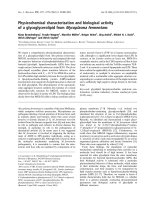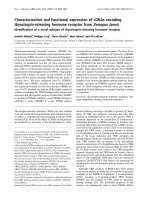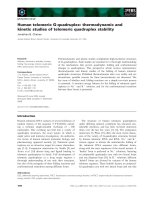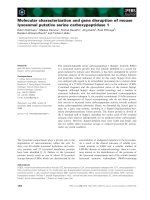Characterization and immunological studies of fish nervous necrosis virus
Bạn đang xem bản rút gọn của tài liệu. Xem và tải ngay bản đầy đủ của tài liệu tại đây (1.76 MB, 179 trang )
CHARACTERIZATION AND IMMUNOLOGICAL STUDIES OF
FISH NERVOUS NECROSIS VIRUS
ASHOK HEGDE
NATIONAL UNIVERSITY OF SINGAPORE
2003
CHARACTERIZATION AND IMMUNOLOGICAL STUDIES OF
FISH NERVOUS NECROSIS VIRUS
BY
ASHOK HEGDE (MFSc)
A THESIS SUBMITTED FOR
THE DEGREE OF DOCTOR OF PHILOSOPHY
DEPARTMENT OF BIOLOGICAL SCIENCES
NATIONAL UNIVERSITY OF SINGAPORE
2003
I
ACKNOWLEDGEMENTS
First of all, I would like to express my deep sense of gratitude and appreciation to
my PhD supervisor, Associate Professorial Fellow Sin Yoke Min and co-supervisor
Professor LamToong Jin for their kind guidance, consistent encouragement and critical
comments throughout the course of my PhD programme.
I sincerely thank my Ph.D. committee members, Associate Professor Wong Sek
Man and Dr. Chen Changlin for their advice and timely help during the course of my
study. I admire necessary help provided by Dr. Qin Qiwei, in my research work.
My lab mates, Jeffry Seng Eng Kuan, Lam Siew Hong, Huang Weidong, Lim Sze
Yun, Jeanne, Christine Fock and Christina Liew have been very friendly and helpful
during my research work. Lab technicians, Mrs. Wei Fong and Mr. Loh Mun Seng have
been very helpful in providing necessary help. I extend my heartfelt thanks to all of them.
I appreciate the help of Madam Loy Gek Luan in taking excellent electron
micrograph pictures. Mrs. Ngoh and Dr. Chang Siew Fong of Agricultural and Veterinary
Authority of Singapore have been very helpful in providing virus and cells whenever
necessary. I remain grateful to them. I acknowledge the research collaboration with
Singapore Fish Breeding and Immunization Centre, Teo Way Yong (Pte) Ltd, Singapore.
My friends, Srinivasa Rao, Narayana Murthy, Sudha P.M, Sasi Nayar, Rahul Sen,
Eeshwarappa Sridhara, Satish, Venugopal, Somashekhar Gouri, Bhinu, Adaikalam, Dr.
Adrian Elangovan, Dr. Sugumar, Dr. Byrappa Venkatesh, Dr. Satish R.L and Dr. Konda
Reddy have been very helpful during the years of my stay here. Affection of my parents,
brother, sisters, uncles and aunts has been the pillar of inspiration for my success. I
greatly acknowledge their moral support. I would like to thank all my past and present
II
teachers for constantly inspiring me to study. Last, but not the least, I acknowledge the
Research Scholarship provided by the National University of Singapore to do my PhD
degree.
III
TABLE OF CONTENTS
TITLE
ACKNOWLEDGEMENTS I
TABLE OF CONTENTS III
LIST OF TABLES X
LIST OF FIGURES XI
LIST OF ABBREVIATIONS XIII
SUMMARY 1
GENERAL INTRODUCTION 3
I. REVIEW OF LITERATURE 8
I.1 Fish viral diseases 8
I.2 Nodaviridae 9
I.2.1 Alphanodavirus 9
I.2.1.1 Virion properties and molecular biology 14
1.2.1.2 Host range 17
I.2.2 Betanodavirus 18
1.2.2.1 Background 18
I.2.2.2 Members of the family 19
I.2.2.3 Host range 20
I.2.2.4 Clinical signs 20
I.2.2.5 Experimental infection experiments 24
I.2.2.6 Histopathology 26
I.2.2.7 Ultrastructural studies 28
IV
I.2.2.8 Diagnosis 28
I.2.2.8.1 Molecular diagnostics 28
I.2.2.8.2 Immununological detection 29
I.2.2.8.3 Histopathology 30
I.2.2.8.4 Electron microscopy 30
I.2.2.8.5 Cell culture 31
I.2.2.9 Viral structure and composition 32
I.2.2.10 Antigenic similarity 33
I.2.2.11 Structural studies 34
I.2.2.12 Epidemiology 34
I.2.2.13 Control 36
CHAPTER ONE
CHARACTERIZATION AND PATHOGENICITY
STUDIES OF A NERVOUS NECROSIS VIRUS
ISOLATED FROM GROUPER, EPINEPHELUS
TAUVINA IN SINGAPORE
38
Abstract 38
1.1 Introduction 39
1.2 Materials and Methods 40
1.2.1 Cell culture 40
1.2.2 Viral isolate 40
1.2.3 Tissue culture infective dose 50 (TCID
50
) 41
1.2.4 Purification of virus 41
V
1.2.5 Electron microscopy 42
1.2.6 Sodium dodecyl sulphate polyacrylamide gel electrophoresis
(SDS-PAGE)
42
1.2.7 N-terminal sequence analysis 43
1.2.8 Polymerase chain reaction (PCR) 43
1.2.9 Polyclonal antisera against the purified virus and coat
protein
44
1.2.10 Western blotting 45
1.2.11 In vivo infection experiment 45
1.2.12 Histopathology of infected larvae 46
1.2.13 Isolation of ETNNV from artificially-infected sea bass
larvae
46
1.3 Results 46
1.3.1 Susceptibility of cell line to virus infection 46
1.3.2 Electron microscopy 47
1.3.3 SDS-PAGE, N-terminal sequence analysis 47
1.3.4 Polymerase chain amplification of virus coat protein gene 47
1.3.5 Antibodies and Western blotting 52
1.3.6 Experimental infection 52
1.4 Discussion 56
VI
CHAPTER TWO
DETERMINATION OF GENOME SEQUENCE OF
EPINEPHELUS TAUVINA NERVOUS NECROSIS
VIRUS AND EXPRESSION OF RECOMBINANT COAT
PROTEIN
61
Abstract 61
2.1 Introduction 63
2.2 Materials and Methods 64
2.2.1 RNA extraction and RT-PCR 64
2.2.2 Cloning and sequencing 66
2.2.3 Sequence alignment and phylogenetic analysis 66
2.2.4 Expression and purification of recombinant coat protein in
E. coli
67
2.2.5 Polyclonal antisera against the purified recombinant coat
protein
68
2.2.6 Western blot detection of recombinant protein 69
2.2.7 Design of specific primers for detection of NNV 69
2.2.8 Detection of ETNNV 70
2.2.9 Sensitivity of PCR 70
VII
2.3 Results 71
2.3.1 Nucleotide and deduced amino acid sequence of ETNNV 71
2.3.2 Comparison with other fish nodaviruses 76
2.3.2.1 Nucleotide sequence 76
2.3.2.1 Deduced amino acid sequence 76
2.3.3 SDS-PAGE analysis and western blotting 77
2.3.4 Detection of ETNNV using conserved primers 77
2.4 Discussion 87
CHAPTER THREE
NODAVIRUS INFECTION IN FRESHWATER
ORNAMENTAL FISH, GUPPY, POICELIA RETICULATA
- COMPARATIVE CHARACTERIZATION AND
PATHOGENICITY STUDIES
91
Abstract 91
3.1 Introduction 92
3.2 Materials and Methods 93
3.2.1 Isolation and propagation of virus 93
3.2.2 Determination of TCID
50
94
3.2.3 Viral purification 94
3.2.4 SDS-PAGE and Western Blotting 95
3.2.5 RNA isolation, RT-PCR, cloning and sequencing 95
3.2.6 Sequence analysis 96
VIII
3.2.7 Experimental infection of guppy fry 96
3.3 Results 97
3.3.1 Cytopathic effects 97
3.3.2 SDS-PAGE and Western Blotting 97
3.3.3 RT-PCR, sequencing and analysis of coat protein gene 102
3.3.4 Experimental infection 106
3.4 Discussion 106
CHAPTER FOUR
EVALUATION OF RECOMBINANT COAT PROTEIN
OF
NERVOUS NECROSIS VIRUS AS A VACCINE IN FISH
112
Abstract 112
4.1 Introduction 113
4.2 Materials and Methods 114
4.2.1 Formalin inactivation of ETNNV 114
4.2.2 Preparation of recombinant coat protein for immunization 115
4.2.2.1 Preparation of crude bacterial lysate 115
4.2.2.2 Preparation of pure recombinant protein 115
4.2.3 Immunization of gouramy 116
4.2.4 Immunization of guppy 117
4.2.5 In vitro neutralization of ETNNV and GNNV with rabbit
antibody
118
IX
4.2.6 In vitro virus neutralization with gouramy antisera and
guppy whole-body extract
119
4.3 Results 119
4.3.1 In vitro neutralization of virus infectivity using antisera
from gouramy and whole body-extract from immunized
guppy
120
4.4 Discussion 121
GENERAL CONCLUSION AND FUTURE DIRECTIONS 128
APPENDIX: MEDIA AND REAGENTS PREPARATION 134
REFERENCES 142
X
LIST OF TABLES
Table Page
I.1 List of viruses affecting fish 10
I.2 Important clinical features of viral nervous necrosis virus
(VNN) of larval and juvenile fish
21
I.3 Geographical and species distribution of clinical nervous
necrosis virus (VNN)
22
2.1A Primers used for amplification of RNA1 65
2.1B Primers used for amplification of RNA2 65
3.1 Comparison of nucleotide and amino acid sequences in the
open reading frame of different fish nervous necrosis viruses
103
4.1A In vitro virus neutralization using rabbit antisera 122
4.1B In vitro neutralization of ETNNV using the pre-adsorbed rabbit
polyclonal antisera
122
4.2A In vitro neutralization of GNNV using immunized gouramy
antisera
123
4.2B In vitro neutralization of GNNV and ETNNV using
immunized guppy whole-body extract
123
XI
LIST OF FIGURES
Figure Page
1.1 Photographs showing normal SB cell monolayer and cytopathic
effects caused by ETNNV on the SB cells
48
1.2 Electron micrographs of ETNNV 49
1.3 SDS-PAGE of ETNNV viral structural proteins 50
1.4 Agarose gel electrophoresis of PCR products. 51
1.5A Western blot developed using rabbit antisera raised against the pure
virus and the capsid protein
53
1.5B Western blot developed using the antiserum against the viral coat
protein
54
1.6 Infection of ETNNV on fish larvae 55
1.7 Histopathology of artificially-infected fish 57
2.1A cDNA nucleotide sequences and deduced amino acid sequences of
RNA1 and RNA2 of ETNNV
72
2.1B cDNA nucleotide sequence and deduced amino acid sequence of
RNA2
75
2.2A Comparison of nucleotide and amino acid sequences 78
2.2B Multiple sequence alignment of the ORF of ETNNV, SJNNV,
DLEV, and, T2 region (variable region) of AH95Ori, BFNNV,
RGNNV, JFNNV and TPNNV, generated using CLUSTAL W
(1.8)
79
2.2C Multiple sequence alignment of amino acid sequences of the ORF of
XII
ETNNV, DlEV and SJNNV, obtained using Clustal W (1.8) 82
2.3 Phylogenetic tree constructed based on the nucleotide sequence of
T4 region (conserved region) in 8 strains of fish nervous necrosis
virus
83
2.4 Recombinant protein expressed in E. coli. 84
2.5 Western blot detection of recombinant coat protein of ETNNV using
the rabbit antibody against native coat protein
85
2.6 PCR detection of pGEM-T- NNVR3 plasmid using primers, CF1
and CR1
86
3.1 Fig. 3.1. Cytopathic effects of GNNV on SB cells 98
3.2 SDS-PAGE stained with Coomasie Blue 99
3.3A Western blotting showing the serological relation between GNNV
and ETNNV: membrane was treated with rabbit antibodies raised
against purified ETNNV
100
3.3B Western blotting showing the serological relation between GNNV
and ETNNV: membrane was treated with rabbit antibodies raised
against the native coat protein of ETNNV
101
3.4 Detection of NNV infection on SB cells 104
3.5 Nucleotide and (shown as DNA) deduced amino acid sequence of
the coat protein gene (RNA2) of GNNV
105
3.6 Phylogenetic tree constructed based on the nucleotide sequence in
the T4 region (conserved region) of different nervous necrosis virus
strains
107
XIII
LIST OF ABBREVIATIONS
Aa Amino acid
AVA Agri- Food and Veterinary Authority
BCIP 5-bromo-4-chloro-3-indolyl phosphate
Bp Base pairs
BSA Bovine serum albumin
Cm Centimeter(s)
CPE Cytopathic effect
ºC Degree Celsius
DNA Deoxyribonucleic acid
DIG Digoxigenin
Dpi Days after first immunization
EDTA Ethelyne diamine tetra acetic acid
EMEM Eagles’ minimal essential medium
ELISA Enzyme-Linked Immunosorbent Assay
FAT Fluorescent Antibody test
FCA Freund’s Complete Adjuvant
FCS Fetal calf serum
G Gram
G Gravitational force
HEPES N-2-hydroxyethylpiperazine-N’-2-ethanesulfonic acid
ICTV International Committee on Taxonomy of Viruses
IFAT Indirect Fluorescent Antibody Test
XIV
IPTG Isopropyl-thiogalactoside
Kb kilo base
kDa kilo Dalton
L litre(s)
LB Luria-Bertani broth
M Molarity, moles
Mg Milligram(s)
µm
Micrometer
Min Minute(s)
Ml Milliliter(s)
mM Milli moles
µM
Micro moles
NBT Nitro blue tetrazolium
ND not done
NCR Non coding region
Ng Nanogram
Nm Nanometer
Nt nucleotide (s)
OIE Office International des Epizooties
PAGE Poly acrylamide gel electrophoresis
PAS Periodic Acid-Schiff
PBS Phosphate buffered saline
XV
PCR Polymerase chain reaction
ORF Open reading frame
Pg Picogram(s)
PVDF Polyvinylidene fluoride
Ppm Parts per million
% Percentage
RNA Ribonucleic acid
RT-PCR Reverse transcription - polymerase chain reaction
RDRP RNA-dependent RNA polymerase (RDRP)
TCID
50
Tissue culture infective dose 50
SDS Sodium dodecyl sulfate
TE Tris- EDTA
Tm melting temperature
TSA Tryptic soy agar
TSB Tryptic soy broth
UV Ultraviolet
µg microgram(s)
µl microlitre(s)
UTR Untranslated region
VLPs Virus-like particles
W Watts
X-gal 5- bromo-4-chloro-3-indolyl-B-D-galactopyranoside
1
SUMMARY
Systematic characterization and pathogencity studies of a virus isolated from
diseased marine fish, grouper, Epinephelus tauvina (ETNNV) were carried out. This virus
was cultured on sea bass (SB) cell line. Upon infection on SB cells it induces
characteristic cytopathic effects such as rounding and granulation of cells, localized cell
death and detachment of cells within 3-5 days post-infection. Purification of this virus was
performed using CsCl gradient centrifugation. It has a buoyant density of 1.30- 1.35 g/ml.
Electron microscopic studies of negative stained, purified viral particles revealed that it is
an icosahedral virus with a mean diameter of 28-30 nm diameter. Electron microscopic
observation of ETNNV infected SB cells showed that this virus replicates exclusively in
the cytoplasm and forms paracrystalline array and inclusion bodies. SDS-PAGE analysis
of structural proteins of the purified virus resolved one major polypeptide of
approximately 42 kDa. The nucleotide sequence of RNA1 and RNA2 of this virus was
determined by RT-PCR, cloning and sequencing. The genome organization revealed its
close similarity (> 75%) to fish nervous necrosis viruses and its distant relation (<29%) to
insect nodaviruses. Based on the morphological, biochemical and genomic characteristics
of this virus it was therefore classified as a member of the genus Betanodavirus in the
family Nodaviridae. This virus induces typical viral nervous necrosis in the
experimentally-infected sea bass larvae, as revealed by histopathological changes in the
nervous tissue of infected larvae.
Using the SB cell culture and RT-PCR, a closely related nervous necrosis virus,
designated as guppy nervous necrosis virus (GNNV) was isolated from a diseased
freshwater ornamental fish guppy, Poicelia reticulata. This virus was also characterized
2
and its similarities with the ETNNV were studied. Studies showed that it is a member of
the genus Betanodavirus with close antigenic similarity to ETNNV. Experimental
infection of ETNNV and GNNV in guppy fry showed asymptomatic infection. This
implies the possible spread of virus from marine to freshwater fish.
Immunological studies were carried out to evaluate the efficacy of recombinant coat
protein of ETNNV expressed in E. coli as vaccine. Rabbit antibodies were raised against
the purified ETNNV, coat protein of ETNNV and recombinant coat protein of ETNNV. In
vitro virus neutralization using these rabbit antisera suggested that the coat protein of the
ETNNV is an ideal candidate for developing the recombinant protein vaccine. To study
the efficacy of recombinant coat protein as a vaccine in fish, adult gouramy and guppy
were immunized with recombinant coat protein of ETNNV. In vitro neutralization of virus
infectivity with the anti- ETNNV recombinant coat protein antisera raised in gouramy and
the whole body extract of immunized guppy showed that the recombinant coat protein of
ETNNV can be used as an experimental vaccine to prevent the nervous necrosis virus
infection in fish.
3
GENERAL INTRODUCTION
Escalating demand for fish and shellfish products and decline in wild fish catch
have prompted the upsurge in fish production through aquaculture (Kaushik, 1997). Over
the last three decades, the aquaculture industry has witnessed significant growth and it has
been a major growth industry of the 1990s (Coelen, 1997). Unfortunately, this increase in
aquaculture activity around the world is accompanied by outbreak of several infectious
diseases, which occur due to viruses, bacteria, fungi and parasites resulting in major
economic loss to the industry (Meyer, 1991). On an average, fish diseases account to
nearly 10 percent of the total aquaculture losses every year (Leong and Fryer, 1993). Viral
diseases of fish are a major threat to cultured fish especially during their early age. Fish
diseases caused by viruses have been of intensive investigation since 1960s. However,
developments in study of many of the fish virus diseases have been significantly hampered
by lack of cell culture systems, ultrastructural and molecular studies to understand the
biology of viral diseases.
Prevention and control of fish diseases has been a major goal for fish disease
specialists around the world because of their economic importance. Several methods of
control and prevention of fish diseases have been in use, viz. drug therapy, immunization,
test and slaughter, quarantine and restriction of movement of fish stock, destruction and
reduction of link in the disease transmission cycle and limitation of release of toxic
substances. The drug and antibiotic treatments have been very popular, however, there are
many associated problems with this strategy, such as, the high cost of treatment, strict
regulations to be followed for use of drugs, potential hazard to human and animal health,
short-term protection offered by these treatments and their inefficacy against the viral
4
diseases. However, one of the major problems in control of fish viral diseases has been the
location of viral carriers (Post, 1987). Therefore, of late, immunization against fish viral
diseases has been the method of choice. Complete eradication of many disastrous viral
diseases in higher vertebrates has been achieved by immunization, however, relatively
limited success has been witnessed in the prevention of fish viral diseases. This difference
in success of immunization against fish viral diseases compared to that against viral
diseases of higher vertebrates may be because of several factors such as, existence of
heterogeneous population of fish pathogens in aquatic environment, our limited
understanding of fish immune response towards fish pathogens, or due to problems
associated with vaccine delivery.
As per the review of Evelyn (1997), there are only six commercially available fish
vaccines. Of these, five are formalin-killed vaccines of bacterial origin, namely, Yersinia
ruckerii, Vibrio anguillarum, V. salmonicida, V. ordalli and Aeromonas salmonicida, and
one is a recombinant protein vaccine against Infectious pancreatic necrosis virus (IPNV).
The bacterial vaccines have been highly immunoprotective, however, it is not known what
specific antigens of these vaccines are involved in offering protection (Newmann, 1993;
Stevenson, 1997) although, in many cases the protective substances are likely to be
lypopolysacharides (Munn, 1994). Similarly, several killed vaccines of viral origin, such
as, IPNV, Infectious hematopoitic necrosis virus (IHNV), Viral heamorrhagic septicaemia
virus (VHSV) and Spring viraemia of carp virus (VHSV) have been developed (Leong
and Fryer, 1993). However, the high cost of growing the virus on cell culture, their
inactivitation and purification makes them an expensive and unattractive choice.
Therefore, in the recent years efforts have been directed towards identifying a common
immunogenic protein or epitope of the virus, and expressing it as recombinant protein
5
either in eukaryotic or prokaryotic expression system to use as vaccine to protect fish
against several strains of that virus. Using the recombinant DNA technology, several
economically viable recombinant protein vaccines of fish viruses have been developed
(Christie, 1997; Ellis, 1997; Leong and Fryer, 1993; Lorenzen and Olesen, 1997). In
addition, several DNA vaccines, which can express recombinant protein in vivo have also
been developed for fish viruses (Lorenzen et al., 1999; Heppel, et al., 1998). Furthermore,
as of now, our understanding of fish immune response towards viral pathogens is limited.
Hence, the knowledge of local and systemic aspects of humoral and cell-mediated
immunity involved in offering protection following immunization will be very useful so
that the effectiveness of antigens in stimulating protective immunity could be tested and
monitored (Ellis, 2001).
Nervous necrosis virus has been one of the major pathogens of marine fish over the
last ten years (Munday and Nakai, 1997; Munday et al., 2002). Devastating losses, often
reaching 100% cumulative mortality of the affected population within a short span of 4 - 7
days have been experienced in fish hatcheries due to fish nervous necrosis virus (NNV).
As of now, NNV is reported to affect 32 species of fish belonging to 16 different families
worldwide (Munday et al., 2002). In Singapore, Chua et al. (1995) reported a presumptive
diagnosis of NNV infection in juvenile greasy grouper. Further, Chang et al. (2001)
demonstrated that the local NNV isolates can replicate in sea bass fry (SF) cell line
derived from Asian sea bass (Lates calcarifer). However, a detailed characterization and
classification of local isolates has not been carried out yet. Additionally, there is no
information on immunization trials in fish using these viral isolates. Till date, there are
very few reports (Nakai et al., 1995; Nakai., 2000; Tanaka et al., 2001; Husgard et al.,
2001) of immunization of fish against nervous necrosis virus. Therefore, the present study
6
was aimed at detailed characterization and pathogenicity studies of NNV, and to test the
efficacy of recombinant coat protein of NNV as vaccine against two different isolates of
fish nervous necrosis virus obtained from marine and freshwater fish in this region. There
are four major objectives in the present study, viz:
1) To characterize and study the pathogenicity of nervous necrosis virus (ETNNV)
isolated from the marine fish, grouper, Epinephelus tauvina.
Detailed morphological and biochemical characterization of a nervous necrosis virus
(ETNNV) isolated from a diseased grouper, was carried out. Pathogenicity of this
virus in vitro on sea bass (SB) cells and in vivo on sea bass larvae was investigated.
2) To determine the genome sequence of ETNNV and to express the recombinant
coat protein in Escherichia coli.
Total RNA isolated from ETNNV-infected SB cells was used as template for RT-PCR.
Fragments of the coat protein gene (RNA2) and the RNA-dependent RNA polymerase
gene (RNA1) obtained by RT-PCR were cloned, sequenced and assembled. A 4.3 kb
genome segment of this virus was sequenced, which contains 3007 nucleotides of
RNA1 and 1368 nucleotides of RNA2. The coat protein of ETNNV was expressed as a
recombinant protein in the M15 strain of E. coli.
3) To characterize a nervous necrosis virus (GNNV) isolated from freshwater
ornamental fish, guppy, Poicelia reticulata and to compare its characteristics,
pathogenicity and antigenicity with the marine isolate (ETNNV).
Using SB cell culture and RT-PCR, a nervous necrosis virus was isolated from a
diseased freshwater ornamental fish, guppy, Poicelia reticulata. Biochemical and
genomic characterization of this virus was carried out and, its characteristics,
pathogenicity and antigenicity were compared with those of the marine isolate
7
(ETNNV). The antigenic similarity of this virus with the ETNNV was revealed using
the rabbit antibody raised against the coat protein of ETNNV.
4) To evaluate the potential of using recombinant coat protein of ETNNV as a
candidate vaccine against the viral nervous necrosis in freshwater fish
Adult freshwater gouramy and guppy were immunized using ETNNV recombinant
coat protein. Efficacy of immunization was determined based on the in vitro virus
neutralization ability of antisera from immunized gouramy and whole-body extract
from immunized guppy. In vitro neutralization of virus infectivity was also determined
using rabbit antisera raised against the ETNNV recombinant coat protein.
8
I. REVIEW OF LITERATURE
I.1 Fish viral diseases
Intensive aquaculture and indiscriminate transport of fish species across regions
and continents without proper regulatory measures have led to emergence of a number of
fish viral diseases around the world. Significant losses of cultured and wild populations of
fish occur every year due to viral diseases. In the last three decades, a lot of research work
on fish viral diseases has been carried out, which has added to our understanding of virus
taxonomy, characterization, pathogenicity, and molecular biology. Several useful
diagnostics and vaccines have also been produced to control and prevent viral diseases in
fish although, much remains to be done when compared to our understanding of human
and veterinary viral diseases. The ever-increasing socioeconomic importance of fish
diseases has prompted the ‘fish diseases commission’ of the Office International des
Epizooties (OIE), to provide an ‘International Aquatic Health Code’ (OIE, 2001) for the
proper description and control of fish and shellfish diseases. As per the description of OIE,
the ‘Diseases notifiable to the OIE’ include those diseases which are of socioeconomic
and/or public health importance within countries, and significant to the international trade
in aquatic animals and aquatic animal products. The category of ‘Other significant
diseases’, includes the diseases of current or potential international significance in
aquaculture. According to the OIE code, the notifiable or significant fish virus diseases
comprise of six RNA virus and five DNA virus diseases. The RNA viruses include,
Orthomyxoviridae-Infectious salmon anemia virus (ISAV); Rhabdoviridae-Infectious
hematopoietic necrosis virus (IHNV), Spring viramia of carp virus (SVCV), Viral
haemorrhagic septicaemia virus (VHSV), Nodaviridae-Nervous necrosis virus (NNV),









